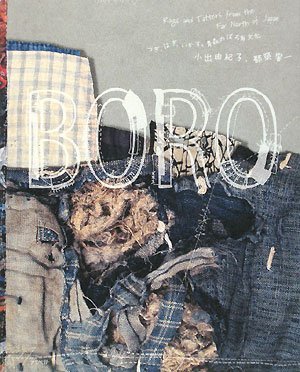Sashiko and Boro reference books – hard to find/out of print editions worth seeking out
Three lovely books for visual and text reference. One in Japanese, and two in both English and Japanese. These are not how-to books, but beautiful resources for getting a feel for sashiko, kogin, and boro textiles in historical context.
Links provided were valid on Amazon at the time I wrote this, but as these books are out of print they may not be available or may be ridiculously expensive. I’ve provided ISBN numbers for the first two you can use to search for these titles outside of Amazon.

津軽こぎんと刺し子 はたらき着は美しい – The Beauty of Tsugaru Kogin and Sashiko Work Clothes – ISBN 978-4864807036
84 pages, full color and black & white photos. Formatted for Japanese market, which means it reads back to front compared to Western books.
This one is filled with artfully photographed closeups of sashiko and kogin garments including festival wear, firefighting gear, aprons, footwear (tabi), mittens, and more in full color. The back pages are text heavy with black and white photos and give historical context to the time and place where these garments were made and worn.
I’ve used this book for inspiration when trying to come up with something I could adapt from historical designs. It can get frustrating looking at a thumbnail image of a garment and then a larger closeup without anything in between, but it does make for a nice artsy book overall.
You don’t have to read Japanese to enjoy this one. The colors are rich and saturated, and the surface textures of the fabrics are clearly visible. It is definitely a much better resource if you do read Japanese, of course. The more I learn the language, the more I get out of this little book.
Japanese text only, no English.

BORO – Rags and Tatters From the Far North of Japan – ISBN 978-4757215962
128 pages, full color photos
List price on this one was around $32 US at the time it was published in 2008. I got my copy at the Amuse Museum in Asakusa in 2013 for a bit more than that, and I’ve clung tightly to it ever since. It’s difficult to find for less than $100 US these days, but you might stumble upon a copy somewhere as if by magic. It can happen!
Please don’t seek this out at a high price, it isn’t worth paying so much for a nice pocket guide to Boro. This book is meant as a reference to accompany the museum exhibit and has no instruction on how to replicate anything in the photos. However, I treasure it for the same reason I love most of my collection, in that it tells the history of the people who made and lived in these clothes. They were poor, they had few resources, and they treasured every scrap.
Text is in English and Japanese. You might need magnification in some places, which is regrettable. They should have just made a larger book!

Mottainai: The Fabric of Life – Lessons in Frugality from Traditional Japan – (no ISBN)
60 pages, full color photos
Published to accompany an exhibition by Gallery Kei & Sri at the Portland Japanese Garden in 2011, this book is ridiculously difficult to find. List price at publication was $30, and I think I nabbed one of the last copies available through Sri several years ago.
This book stands out in my collection in that it goes into great detail–at the microscopic level–to show the difference between various fibers used throughout Japan before cotton rose to prominence. Included in this slim volume are Shi-fu (paper), Kuzu (kudzu), Fuji (wisteria), and other fibers displayed as garments, in closeups, and under a microscope. The closeups are remarkably helpful when you’ve acquired an antique garment of unknown provenance, have no idea what fiber it is, and you don’t want to do a burn test.
The second half of the book covers Japan after the cotton boom and includes boro, zanshi-ori (scrap thread weaving), saki-ori (rag weaving), and a variety of uses for these types of cloths.
If you’re a textile researcher, antiques collector, or really into Japanese textiles, this is worth snagging a copy if you ever see it at a library sale or such.
Text is in English and Japanese. Font size varies from rather small to decently readable.